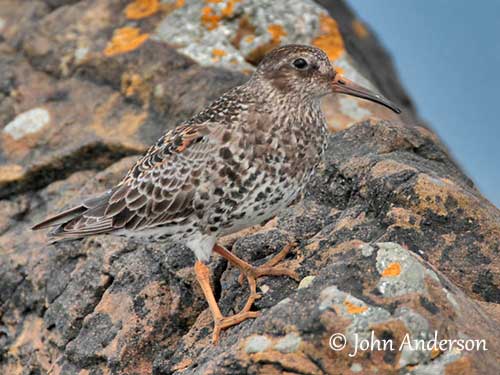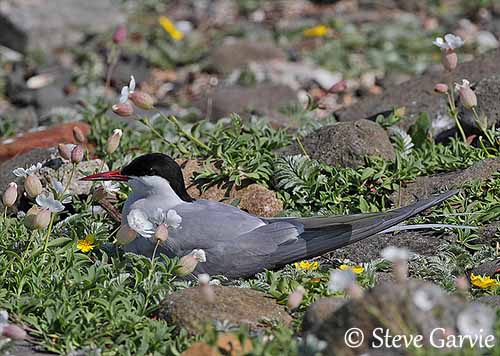

John Anderson
John Anderson Photo Galleries
Bird list:
Atlantic Puffin – Fratercula arctica – Macareux moine
Arctic Tern - Sterna paradisaea – Sterne arctique
Barnacle Goose - Branta leucopsis - Bernache nonette
Black Guillemot - Cepphus grylle - Guillemot à miroir
Black-legged Kittiwake - Rissa tridactyla - Mouette tridactyle
Black-throated Diver (Loon) - Gavia arctica - Plongeon arctique
Brant Goose - Branta bernicla - Bernache cravant
Common Eider - Somateria mollissima - Eider à duvet
Common Sandpiper - Actitis hypoleucos - Chevalier guignette
Eurasian Hobby - Falco subbuteo - Faucon hobereau
Glaucous Gull - Larus hyperboreus - Goéland bourgmestre
Hen Harrier – Circus cyaneus cyaneus – Busard St Martin
Horned Lark - Eremophila alpestris – Alouette hausse-col
Ivory Gull - Pagophila eburnea - Mouette blanche
Leach’s Storm-Petrel - Oceanodroma leucorhoa - Océanite cul-blanc
Little Auk or Dovekie - Alle alle - Mergule nain
Long-tailed Jaeger - Stercorarius longicaudus - Labbe à longue queue
Merlin - Falco columbarius - Faucon émerillon
Northern Fulmar – Fulmarus glacialis – Fulmar boreal
Parasitic Jaeger or Arctic Skua - Stercorarius parasiticus - Labbe parasite
Peregrine Falcon - Falco peregrinus - Faucon pèlerin
Pink-footed Goose - Anser brachyrhynchus - Oie à bec court
Purple Sandpiper - Calidris maritima - Bécasseau violet
Red-throated Diver (Loon) - Gavia stellata - Plongeon catmarin
Rock Ptarmigan - Lagopus muta - Lagopède alpin
Ross’s Gull - Rhodostethia rosea - Mouette de Ross
Sanderling – Calidris alba - Bécasseau sanderling
Snow Bunting - Plectrophenax nivalis - Bruant des neiges ou Plectrophane des neiges
Thick-billed Murre - Uria lomvia - Guillemot de Brünnich
White Wagtail - Motacilla alba - Bergeronnette grise
Wood Sandpiper - Tringa glareola - Chevalier sylvain

Steve Garvie
RAINBIRDER Photo galleries & Flickr Rainbirder
BIRD SPECIES OF FRANZ JOSEF LAND
IN THE RUSSIAN ARCTIC NATIONAL PARK
Franz Josef Land is an archipelago located in Arctic Ocean, Barents Sea and Kara Sea. It is part of the Russian Arctic National Park established in June 2009. This park covers a remote area of the Arctic Ocean, including Franz Josef Land and the northern part of Novaya Zemlya (Severny Island).
Franz Josef Land consists of 191 islands covering an area of 16,134 square kilometres (375/234 km), that are categorized in three groups, western, central and eastern groups, separated by the British Channel (not the English Channel) and the Austrian Strait. These islands are uninhabited.
The highest location is found in the eastern group, with 670 metre above sea-level on Wilczek Land. The islands are 900 kilometres from the North Pole, and 750 kilometres from the Yamal peninsula, the closest point of the Eurasian mainland.
The archipelago is glaciated at 85%. Large unglaciated areas are found on the largest and the smallest islands and most of the smaller islands are unglaciated.
There are streams and lagoons, and numerous lakes located in depressions caused by the erosion. The pack ice occurs throughout the year around the archipelago, and icebergs are common year-round.
The flora is based on natural conditions and varies between islands and with the elevation. It consists mainly of mosses and lichens, because trees, shrubs and tall plants cannot survive. In wet areas, buttercups, Alopecurus alpinus, polar willow and Papaver dahlianum (or Svalbard poppy), are common.
There are no endemic bird species within Franz Josef Land, but 31 species have been documented and some of which breed there. Avian species include mainly seabirds such as Northern Fulmar, Black-legged Kittiwake, Thick-billed Murre, Black Guillemot and Little Auk that are common throughout the archipelago.
Other bird species nest on flat tundra, including Common Eider, Purple Sandpiper, Arctic Skua, Glaucous Gull, Ivory Gull, Arctic Tern and Snow Bunting.
Some of them spend sometimes the winter on the islands.
The tourism is severely limited and the only way to reach the islands is by icebreaker. The most popular destinations are the cliffs where birds are nesting and the walrus colonies.
These volcanic islands were officially discovered in 1873 by the Austro-Hungarian North Pole Expedition. The name of these islands pays tribute to the Austro-Hungarian Emperor Franz Josef I.
Text by Nicole Bouglouan
Sources:
Wikipedia, the free encyclopaedia
Franz Josef Land: Forbidding Islands of the High Arctic